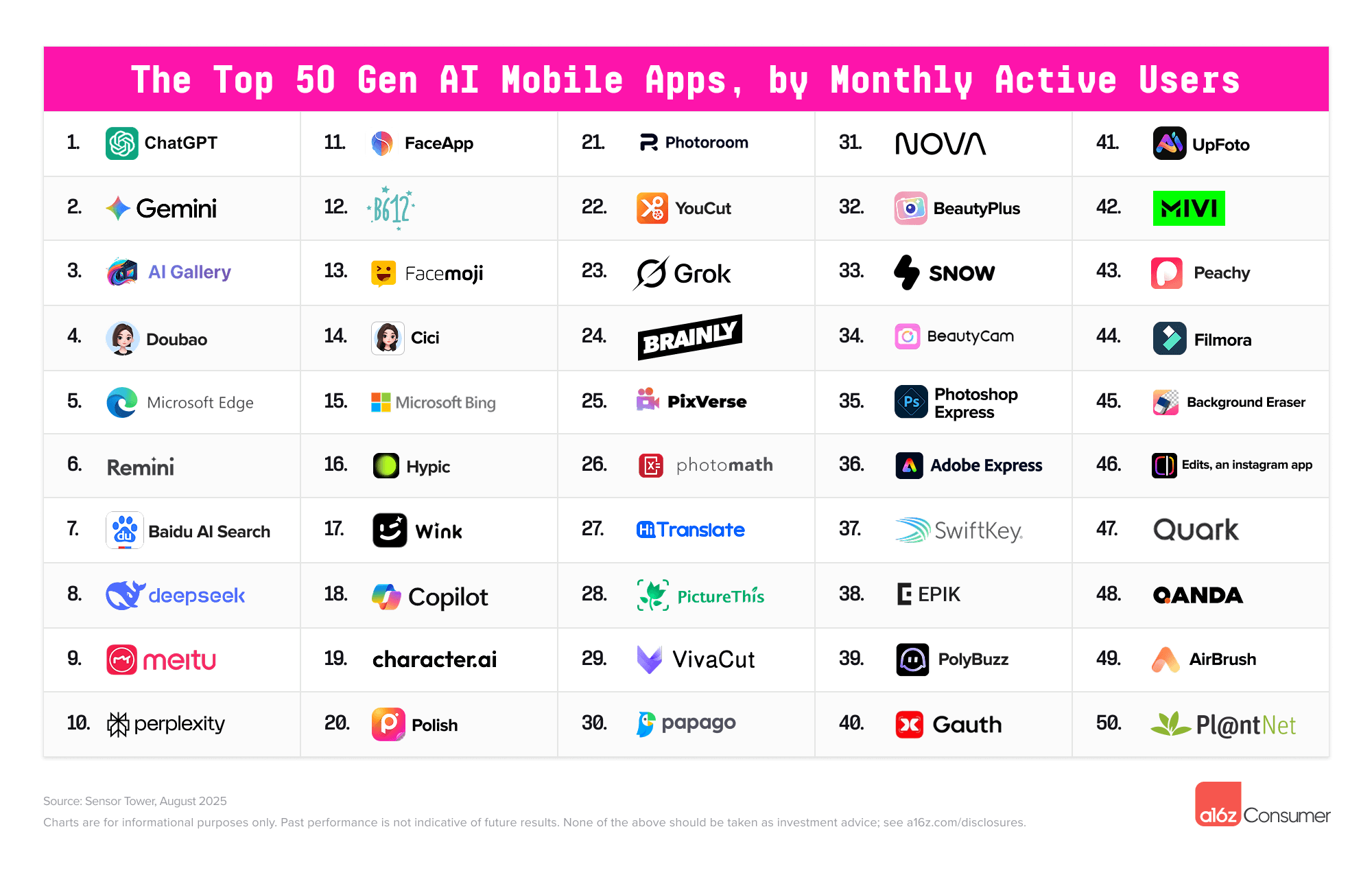After more than two years of tracking how people use artificial intelligence in everyday life, the latest survey of consumer apps suggests the market is beginning to level out. The report, compiled by Andreessen Horowitz, shows fewer new entrants than earlier editions, even as competition at the top remains intense and fresh categories continue to emerge.
Growth Patterns Become Clearer


In previous rankings, the landscape shifted rapidly with large numbers of newcomers appearing each time. This latest edition shows fewer changes on the web list, although mobile still brought in a wider set of fresh names as app stores cracked down on copycats and left space for more original products. That balance points to a sector maturing, with leading services building durable user bases rather than temporary spikes.
Google’s Expanding Role
A major shift came from Google, which for the first time had its AI services measured separately rather than combined. That change made visible just how much ground the company has gained. Gemini, its main conversational assistant, ranked second on both mobile and web, drawing about half as many monthly users as ChatGPT and performing particularly well on Android. Developer tool AI Studio entered the top ten web products, NotebookLM followed closely behind, and Google Labs climbed into the rankings after a traffic surge tied to new experimental launches.
Grok Accelerates
xAI’s Grok also advanced quickly. Starting from almost no footprint at the end of 2024, it has grown into a service with more than twenty million monthly users. By mid-2025 it reached fourth place on the web chart and broke into the top twenty-five on mobile. Much of that momentum came in July when the release of Grok 4 drew in large numbers of new users, followed shortly after by the addition of customizable avatars that proved popular.
Meta and Other Assistants
Meta’s assistant expanded at a slower pace, holding a mid-table position on the web while missing out on the mobile list. Elsewhere, other general assistants showed mixed fortunes. Perplexity and Claude continued to attract users, while DeepSeek dropped sharply from its early-year peak. Together, these shifts underline how crowded the assistant category has become, with only a few services sustaining long-term growth.
China’s Increasing Presence
One of the more striking trends is the growing role of Chinese companies. Several domestic platforms ranked in the global top twenty for the web, including ByteDance’s Doubao, Moonshot AI’s Kimi, and Alibaba’s Quark. Many of these services also perform strongly on mobile, with Doubao reaching fourth place. Beyond those leading names, more than twenty of the fifty mobile apps originated in China, though only a small share serve primarily local users. Much of this growth is concentrated in video and image applications, areas where Chinese developers continue to hold an edge.
Vibe Coding Gains Momentum
Another notable development is the rise of platforms that let users generate and publish applications with minimal effort. Lovable and Replit both broke into the rankings this year after sharp traffic increases. Early signs suggest these users do not disappear quickly but instead build more projects and expand their spending, which in turn drives activity across other AI tools. This movement, sometimes called vibe coding, has grown from a niche experiment into a visible part of the consumer market.
Long-Term Leaders Hold Their Place
Amid these changes, a consistent group of companies continues to appear in every edition of the list. They span general assistants, creative image and video tools, voice generation, productivity apps, and hosting platforms. Their ongoing presence highlights that while many new entrants rise and fall, a smaller circle of services has managed to stay central to how people use AI on a daily basis.
Outlook
The report paints a picture of a sector that is no longer in its earliest, most volatile stage. Fewer fresh names are breaking into the rankings, yet the pace of innovation has not disappeared. Instead, growth is consolidating around large assistants such as ChatGPT, Gemini, and Grok, while new activity comes from different directions, whether in China’s domestic platforms or in experimental spaces like vibe coding. The balance suggests consumer AI is entering a steadier phase, but one that still leaves room for surprises.
Notes: This post was edited/created using GenAI tools.
Read next: Google Brings AI-Powered Avatars to Its Video Tool While Opening Access to Casual Users
